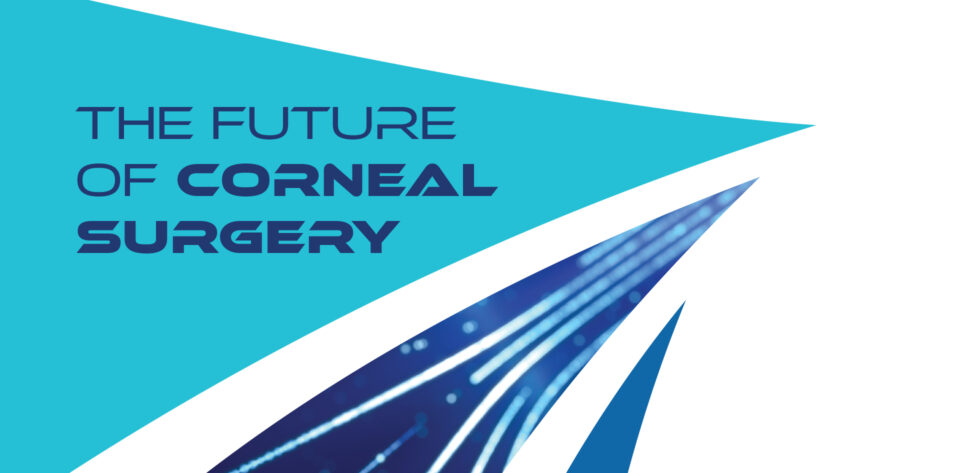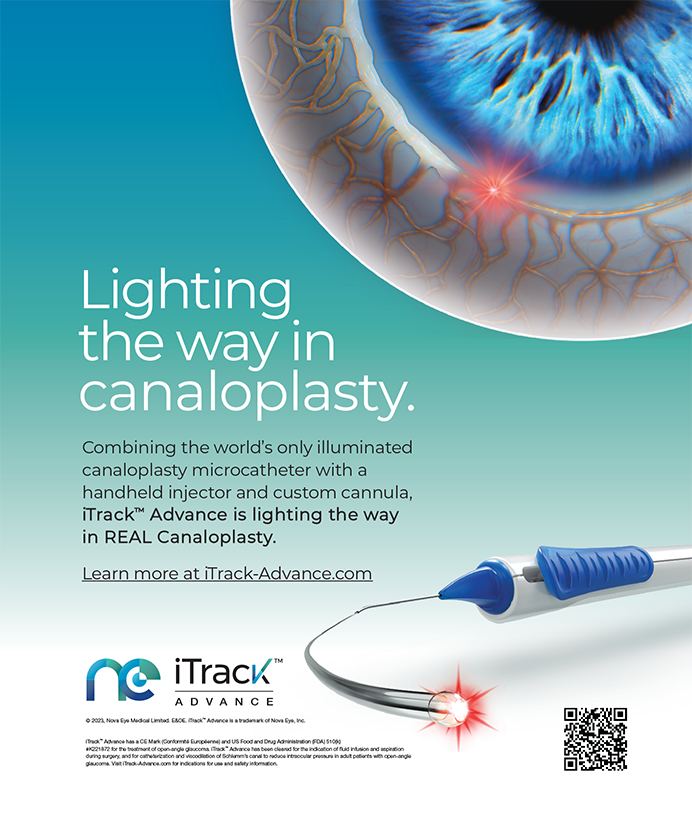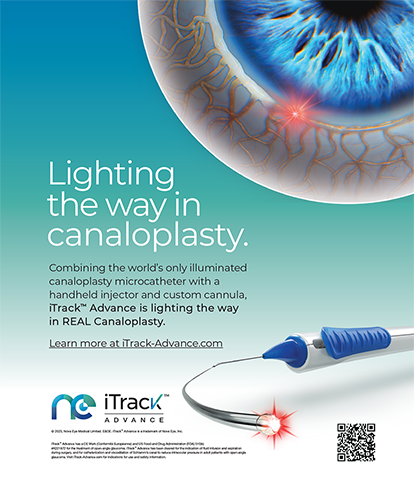

The cornea, accounting for two-thirds of the total refraction, has the most refractive power of the eye. Accurate measurement of the cornea’s shape is crucial for planning refractive and cataract surgeries, as errors can lead directly to suboptimal refractive outcomes. Inaccurate keratometry values, for example, can result in inappropriate IOL power selection for cataract patients, inaccurate assessments of astigmatism, and the need for additional surgery (eg, LASIK, piggyback IOL, or IOL exchange) to correct an undesired visual outcome.
Ocular surface deficiencies and corneal pathology can lead to errors in keratometry, incorrect identification of the astigmatism axis, and inaccurate IOL power calculations. Conditions such as dry eye disease, epithelial basement membrane dystrophy, and pterygium must be addressed to optimize the health of the ocular surface before preoperative measurements are obtained.
Advances in technology continue to enhance the accuracy of anterior segment measurements for surgical planning.
PLANNING CATARACT SURGERY
Swept-source OCT (SS-OCT) topography with integrated biometry systems, such as the Anterion (Heidelberg Engineering) and Casia SS-1000 (Tomey), are a recent addition to ophthalmologists’ armamentarium. Unlike posterior segment OCT devices, SS-OCT systems use a longer wavelength of light (approximately 1,300 nm) and have fixation targets that are in focus at the imaging plane to ensure repeatable measurements. Built-in software analyzes the recorded images to generate axial and refractive corneal powers, pachymetry measurements, elevation maps, and automatic quantitative anterior segment evaluations. This longer wavelength is more effective at penetrating media opacities such as dense cataracts, corneal infiltrates, and corneal scars.1 SS-OCT measurements have been shown to have equal or better repeatability of corneal biometric measurements in both healthy and pathologic corneas compared to traditional methods such as Scheimpflug imaging.2,3
A significant limitation of SS-OCT systems is their inability to measure the surface’s true curvature but rather that of the reconstructed image. Movement due to ocular saccades, change of head position, or even respiration can reduce the accuracy and reliability of measurements. Both the Anterion and the Casia SS-1000 use eye tracking technology and quick acquisition time to improve accuracy. The former also has a feature called image averaging to improve the image signal-to-noise ratio. Intraobserver and intradevice measurement repeatability, however, were similar for unaveraged Casia images and averaged Anterion images in a 2020 study.4
PLANNING REFRACTIVE SURGERY
New technologies for measuring corneal biomechanics can be broken into two broad categories: (1) software to detect abnormal corneal shape based upon standard imaging techniques and (2) methods for investigating biomechanical corneal characteristics.
Two commercially available devices are capable of characterizing biomechanics in vivo: the Corvis ST (CST; Oculus Optikgeräte) and Ocular Response Analyzer (ORA; Reichert). Both measure dynamic corneal response to applanation tonometry via a puff of air.
ORA. The ORA delivers air puffs to induce pressure on the corneal surface and optically measures the deformation and recovery of the cornea. The difference between the inward and outward pressure values is reported as corneal hysteresis, and a corneal resistance factor is calculated using a linear relationship between the two pressures. Evidence suggests, however, that corneal hysteresis is affected by other factors, including IOP, myopia, corneal thickness, and corneal hydration. The diagnostic accuracy of corneal hysteresis has shown particularly poor predictive value as central corneal thickness increases.5
CST. Like the ORA, the CST applies pressure to the cornea using air puffs, but it uniquely incorporates a high-speed Scheimpflug camera for measuring corneal biomechanical deformation. The CST provides quantitative measurements such as deformation amplitude. Early iterations of the device demonstrated relatively low accuracy for ectasia detection. New parameters have been introduced and are being developed to improve the accuracy of biomechanical assessment.6
Both the ORA and CST aim to characterize the biomechanical properties of the central 3 mm of the cornea. They do not represent the peripheral structure, which may be particularly relevant in ectatic disorders of the cornea. The systems also cannot capture regional differences in corneal biomechanical properties. Clinical trials have shown conflicting outcomes when corneal biomechanics were measured with these methods.
In response to the limitations of the ORA and CST, new techniques have been proposed that do not rely on placing stress on the cornea.
Brillouin optical microscopy. Brillouin optical microscopy is a promising new technology being developed to detect subtle differences in the biomechanical properties of the cornea. It analyzes the return signal of light (laser beam) scattered in a tissue.7 The magnitude of Brillouin frequency is proportional to the propagation speed of the beam in the tissue and provides a direct measurement of regional areas of the tissue. A downside to Brillouin optical microscopy is its long acquisition time (4–8 minutes), which makes measurements highly susceptible to motion artifacts.
Optical coherence elastography. Optical coherence elastography uses a stimulus to apply forces to a tissue and an OCT system to observe the subsequent tissue displacements (strains) or mechanical waves for tissue biomechanical property estimation.
Ocular pulse elastography. The stimulus of ultrasound energy was recently described as ocular pulse elastography.8
Although optical coherence elastography, ocular pulse elastography, and Brillouin optical microscopy show potential, further studies are required to determine their validity in measuring corneal biomechanics.
CONCLUSION
The ability to detect subtle differences in the biomechanical properties of the cornea has wide-ranging implications for clinical research, diagnostic tools, and surgical treatment planning.
1. Hirnschall N, Varsits R, Doeller B, Findl O. Enhanced penetration for axial length measurement of eyes with dense cataracts using swept source optical coherence tomography: a consecutive observational study. Ophthalmol Ther. 2018;7(1):119-124.
2. Schröder S, Mäurer S, Eppig T, Seitz B, Rubly K, Langenbucher A. Comparison of corneal tomography: repeatability, precision, misalignment, mean elevation, and mean pachymetry. Curr Eye Res. 2018;43(6):709-716.
3. Szalai E, Németh G, Hassan Z, Modis L Jr. Noncontact evaluation of corneal grafts: swept-source Fourier domain OCT versus high-resolution Scheimpflug imaging. Cornea. 2017;36(4):434-439.
4. Pardeshi AA, Song AE, Lazkani N, Xie X, Huang A, Xu BY. Intradevice repeatability and interdevice agreement of ocular biometric measurements: a comparison of two swept-source anterior segment OCT devices. Transl Vis Sci Technol. 2020;9(9):14.
5. Fontes BM, Ambrósio R Jr, Velarde GC, Nosé W. Ocular response analyzer measurements in keratoconus with normal central corneal thickness compared with matched normal control eyes. J Refract Surg. 2011;27(3):209-215.
6. Ambrósio R Jr, Lopes BT, Faria-Correia F, et al. Integration of Scheimpflug-based corneal tomography and biomechanical assessments for enhancing ectasia detection. J Refract Surg. 2017;33(7):434-443.
7. Scarcelli G, Yun SH. Confocal Brillouin microscopy for three-dimensional mechanical imaging. Nat Photonics. 2007;2:39-43.
8. Clayson K, Pavlatos E, Pan X, Sandwisch T, Ma Y, Liu J. Ocular pulse elastography: imaging corneal biomechanical responses to simulated ocular pulse using ultrasound. Transl Vis Sci Technol. 2020;9(1):5.




